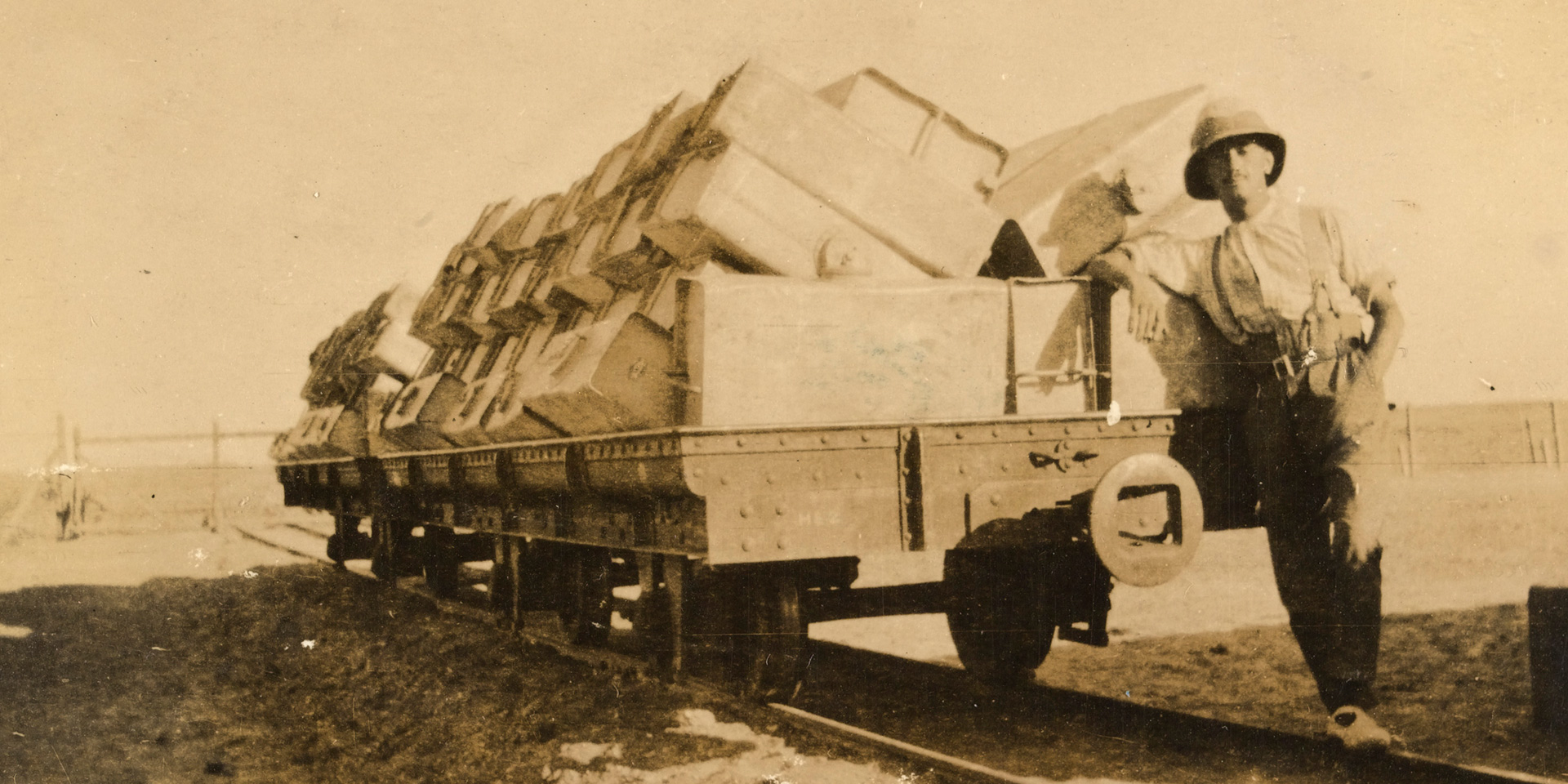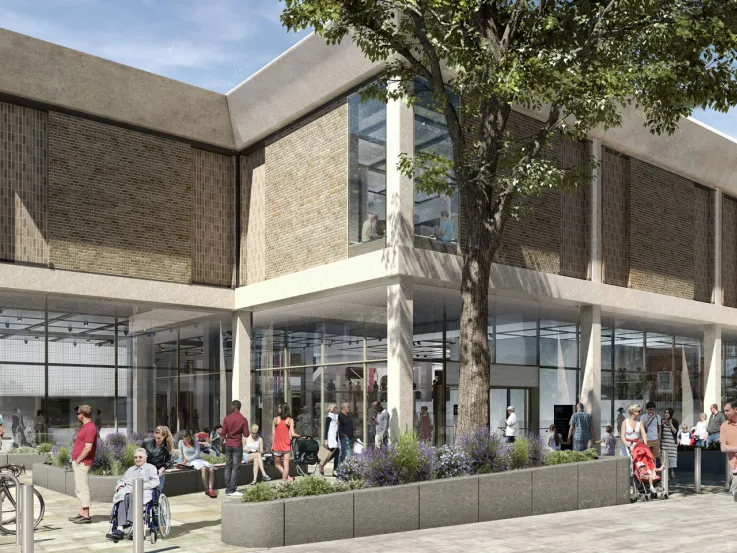Welsh soldier’s photos reveal the logistical problems of a desert war
The previously unseen personal photographs of a Welsh soldier who served in Egypt during the First World War are being published online by the National Army Museum. Corporal Joseph Egerton’s extraordinary collection documents the British campaign in the Sinai Peninsula, which culminated in an Allied victory at the Battle of Rafa on 9 January 1917, exactly 100 years ago.
Egerton, who was born in Wales in 1884, served in Egypt between 1916 and 1918. His personal photographs from his time in Egypt depict a range of local people and street scenes, as well as evidence of the harsh desert warfare faced by British soldiers in the Sinai Peninsula.
The campaign in Sinai began in January 1915 when the Ottoman Empire attempted to raid the Suez Canal in the British Protectorate of Egypt. Although the attack was repelled, the Ottomans remained a threat to the strategically important waterway. In order to secure the peninsula the British would need to push through hundreds of miles of arid desert.
Joseph Egerton’s photographs show how the British Army was forced to adapt to the punishing conditions of the Sinai Peninsula. Egerton, who had worked as a railway clerk before the First World War, took a particular interest in the construction of the railway line that would eventually stretch hundreds of miles to the Palestine border. Photographs of tracks, carriages and rolling stock demonstrate the huge logistical challenge of desert warfare.
His photos also document the support of the Egyptian Camel Transport. Between 1916 and the end of the Sinai and Palestine Campaign in 1918, 170,000 Egyptian volunteers and their 72,500 camels transported water, food, and medical supplies to and from the British front. Camels were also used as ambulances, able to carry two wounded soldiers at a time.
Emily Charles, Digital Content Producer at the National Army Museum, said:
‘Corporal Joseph Egerton’s personal photographs provide a rich soldier’s-eye-view of the War in Egypt and Palestine. He was clearly fascinated by the new people, sights and cultures he encountered. But at the same time, they are a valuable record of how the British Army overcame the huge logistical task of fighting in the desert.’
The Sinai Campaign ended with the British victory at the Battle of Rafa on 9 January 1917, where around 1,500 Ottomans were taken prisoner. While the battle itself was short and bitter, it finally expelled the Ottomans from the Sinai Peninsula. This marked the beginning of the Palestine Campaign, and a new phase of the war in the desert, with an advance on Gaza to directly attack the Ottoman Empire.
Notes for editors
For more information, please contact the National Army Museum press office at pr@nam.ac.uk or 020 7881 2433.
Corporal Joseph Egerton
Joseph Egerton (1884-1952) was born in Blaenau Ffestiniog, Merionethshire, Wales on 17 December 1884. At a young age his father died and he was sent to live with his grandmother in Corwen. Egerton’s father had been a railway clerk, and his step-grandfather Samuel a railway engine driver, so naturally the 15-year-old Joseph also joined the family profession as a ‘Passenger’ (member of engineering staff) in December 1899, later becoming a railway clerk.
In August 1914, Egerton signed up for service with the 1/1st Shropshire Yeomanry, part of the Welsh Mounted Division. After a year spent on home defence duties in East Anglia during 1915, he was sent to the Middle East. Now promoted to corporal, he arrived in Egypt on 15 May 1916, and was sent to Minia, as a vice-cook to the Camel Corps.
Egerton spent much of his time in Sinai and Palestine suffering from ailments and diseases brought on by the desert conditions, and was admitted to hospital four times in his first year in Egypt. Armed with his camera, he took numerous photographs of Egyptian street scenes and people, and he captured the bleak desert conditions faced by the British Army working in the area.
Egerton’s regiment arrived in France in May 1918 and took part in the Second Battle of the Somme in August and September. Shortly afterwards he was wounded in a gas attack and witnessed the end of the war while recovering at the Command Depot at Heaton Park, Manchester.
Egerton was discharged from the Army on 10 March 1919. Later that year he married Hetty Barclay Taylor in Stockport, Cheshire. The couple had a son John, who was born on 13 January 1924. Egerton resumed his career as a railway clerk, working with Great Western Railway in Manchester and later Birmingham into the 1930s. He retired during the Second World War and lived in Scarborough, Yorkshire in later life. Egerton died there aged 68 on 26 December 1952.
National Army Museum
The National Army Museum is the leading authority on the history of the British Army. Founded in 1960 by Royal Charter and established for the purpose of collecting, preserving and exhibiting objects and records relating to the Land Forces of the British Crown it is a museum that moves, inspires, challenges, educates and entertains.
The Museum tells the story of the British Army, the personal experiences of the soldiers who have served and connects the British public and its Army demonstrating how the role of the Army and its actions are still relevant today.
Heritage Lottery Fund
Using money raised through the National Lottery, the Heritage Lottery Fund (HLF) aims to make a lasting difference for heritage, people and communities across the UK and help build a resilient heritage economy. HLF has supported 36,000 projects with £6bn across the UK.
For more information, please contact Katie Owen, HLF press office, on tel: (020) 7591 6036 out of hours mobile: 07973 613820.


